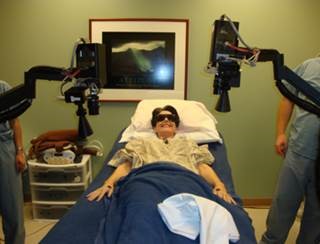For more than two decades I’ve had the opportunity to work with Dr. Eva Sevick and her team at the University of Texas Health Science Center, Houston on the development of real-time lymphatic imaging. In fact, above is a photo of me many years ago, with one of the earliest generations of a camera which uses military-grade night-vision goggle technology to detect the flourescence of intradermal indocyanne green as it’s picked up by the lymphatics. Below is a photo of Dr. Erick Maus giving me a microdose intradermal injection of ICG.

Seeing the images of the lymphatics at work was like Columbus discovering the New World. The amazing lymphedema therapists I worked with had been telling me that they could feel lymphatic dysfunction in some patients, even though they did not have edema. I was skeptical about this. However, over the years, we proved that is indeed the case. There are patients who appear to be normal clinically, but their lymphatics as visualized with ICG are not normal at all. We’ve seen the lymphatics cross the midline (which has profound implications for cancer metastasis) and cross surgical scars. Lymphedema therapists also told me that when they perform lymphatic massage, for example, on the right arm, the left arm lymphatics pump faster. I was skeptical about that, too, but they are right! Because we could get both of my arms into the same image, we saw that they were right. Massaging the right arm makes the left arm lymphatics work faster.
I mention all of this because the Sevick team has just published an incredible article summarizing what we’ve learned about the lymphatics in cancer patients and survivors. It is available open source here, and within the document are links to video images of the lymphatics pumping.
The lymphatic system has been the only organ system for which we had no real-time imaging. The lymphatics control fluid balance in the tissues, are your primary defense against infection, and determine the fate of cancer cells. They may even play a critical role in the development of dementia. Thanks to decades of work by Eva and her team, the mysteries of this vital organ system are gradually being revealed. Check out the article, which has several beautiful and informative illustrations explaining the anatomy and function of the lymphatic system.
“The Development and Treatment of Lymphatic Dysfunction in Cancer Patients and Survivors” has been published in Cancers as part of the Special Issue Cancer Related Lymphedema.

Dr. Fife is a world renowned wound care physician dedicated to improving patient outcomes through quality driven care. Please visit my blog at CarolineFifeMD.com and my Youtube channel at https://www.youtube.com/c/carolinefifemd/videos




So excited to read the latest publication by Dr. Sevick’s team, especially since I was one of those therapists in the clinic where this all took place. I look forward to the day when a physician can order a “real-time” lymphatic imaging for an accurate diagnosis and treatment for lymphatic dysfunction as it relates to not only cancer therapy but autoimmune, venous disorders, etc.
This is so exciting and so important on so many levels! Thanks for everyones hard work in making this much needed tool a reality!